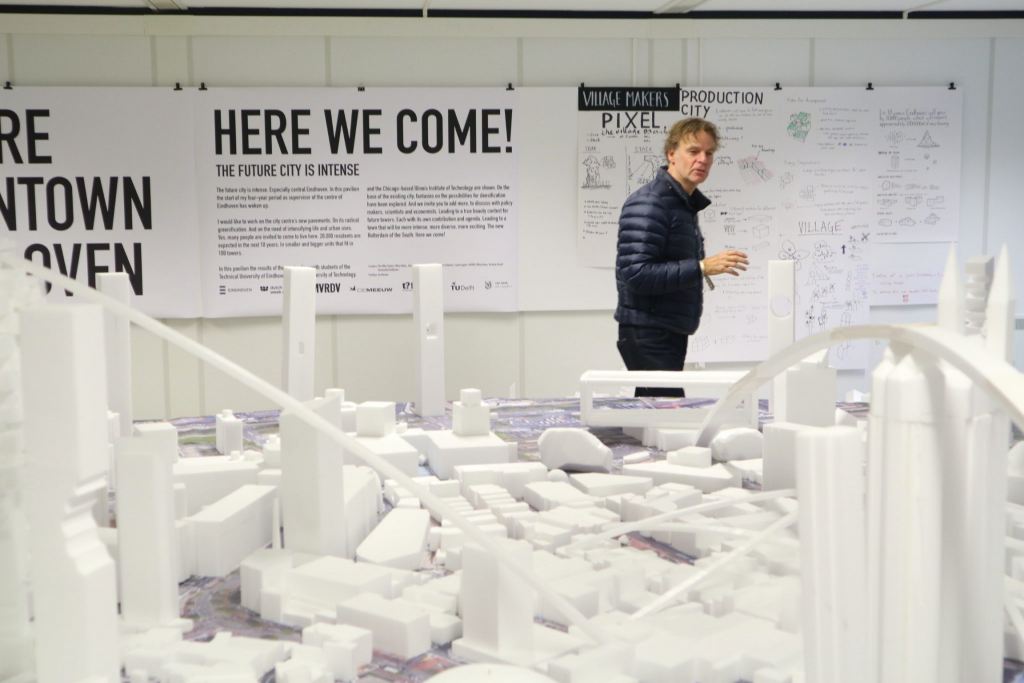

The middle of Stadhuisplein, during Dutch Design Week, is the location for ICI Eindhoven: We’re approaching. This is a platform created for the public to contribute to the discussion about the future of Eindhoven. A large model with architectural ideas for the future of the inner city is right in the middle of the space. Winy Maas, urban planner, architect and one of the ambassadors of Dutch Design Week, explains what ideas have come up so far: “We have set to work without restrictions and ‘yes, buts‘. These are the first ideas, developed together with the Eindhoven University of Technology and TU Delft.” Maas was also appointed as supervisor for the town center’s spatial plans, last summer.
More residents
“With these plans, we are here to help the City Council give direction to the center”, Maas starts his story. “How beautiful are all the red stones and all the corners and holes of the city? How green is it? And how waterproof? These are questions that we must answer. There is also a sustainability challenge and a growth challenge for the centre as a whole. How will we use the roofs, how do we deal with new construction and will we add more greenery? During DDW we’ll find out things for the city that already give a bit of answers. The last task is to make the inner city suitable for more habitation. There are now 5,000 to 7,000 people living in the city centre, which is not much for the size of Eindhoven. People have been drawn to the suburbs. We want to investigate how we can accommodate 20,000 people in the centre.”
“Eindhoven is not yet the most beautiful city in the world, not yet! But wait, because it’s coming there.”Winy Maas, Architect / Ambassadeur Dutch Design Week
Towers
“This is a temporary space, but we would like to have a kind of shop as soon as possible where we can invite people to talk to each other and where we can get a taste of what the inhabitants want. I have already been asked what exactly we’re doing here. The shop needs to make this even clearer. What you don’t see on the model here are the green dip (roof gardens, etc.), the floor covering and the distribution system. What we have done is that we have taken a good look together with the students: what is it all about? The question is how we are going to house those 20,000 people who will be added to the city centre. These are expats and internal removals within Eindhoven. What can you do then? You could build 10,000 houses, 1,000 a year, but you can also express it in towers: in one tower of 900 meters height, then you are ready in one go. There are still some hooks and eyes on it, but who knows, with a beautiful market hall underneath it…”, Maas says with a wink. “But we can also look at towers of Rotterdam’s size, from 100 to 150 meters high. Then you’ll have enough with 20 towers and with even lower towers we’ll be building 40 of them. But what does that mean? We have looked into the numbers with ABN Amro. If we were to create an investment fund, these new houses could generate between €280 and €350 million, roughly calculated. With that kind of money, you could turn the whole Vestdijk into a tunnel. Or we could do the adjustments needed to the railway station in order to accommodate a TGV-stop, or invest in social housing.”

Exciting
A number of ideas can be seen in the model: “We could build something like Ponte Vecchio: habitable bridges between the station and the Van Abbemuseum, for example. But also the edge of the center is very suitable. After all, the inner city is more than just the Vestdijk. If you also look at the edges of the inner city, and you make a kind of Stonehenge, wow, then you really get something. By playing with light and openings in the towers, a beautiful spectacle is created.” While Maas explains everything, he hastily walks around the model. His enthusiasm sparks off his words and gestures. “We need to make it a little more exciting, but also give the people more freedom as to how high they want to build. One of the most exciting ideas I find the Catharina church to be raised in height, in order to build houses underneath it, made of the red stones from the inner city. I know you would have to get used to the idea, but it is also very cool. And one that is technically feasible.”

Evoluon
The team also looked at the icons of the city. The Evoluon is, of course, beautiful, but it’s in the wrong place. Here, with our ideas, it will ‘land’ on the Marketplace. Or how about extending the Stratumseind with a mirror building so that the street looks much longer. Another group of students said that Anton Philips has a far too small statue and that he might also be dedicated to a large building. From my profession and as a Brabander I can tell you that my hands are itching. Eindhoven is not yet the most beautiful city in the world, not yet! But wait, because it is coming. With a very nice arsenal of buildings, public space and greening, we can make a distinct collection with several architects and developers. If we go this way, then I also want a house here.”
ICI Eindhoven can be visited until Sunday, October 29th at Stadhuisplein. It is open from 11:00 to 18:00 hrs.



